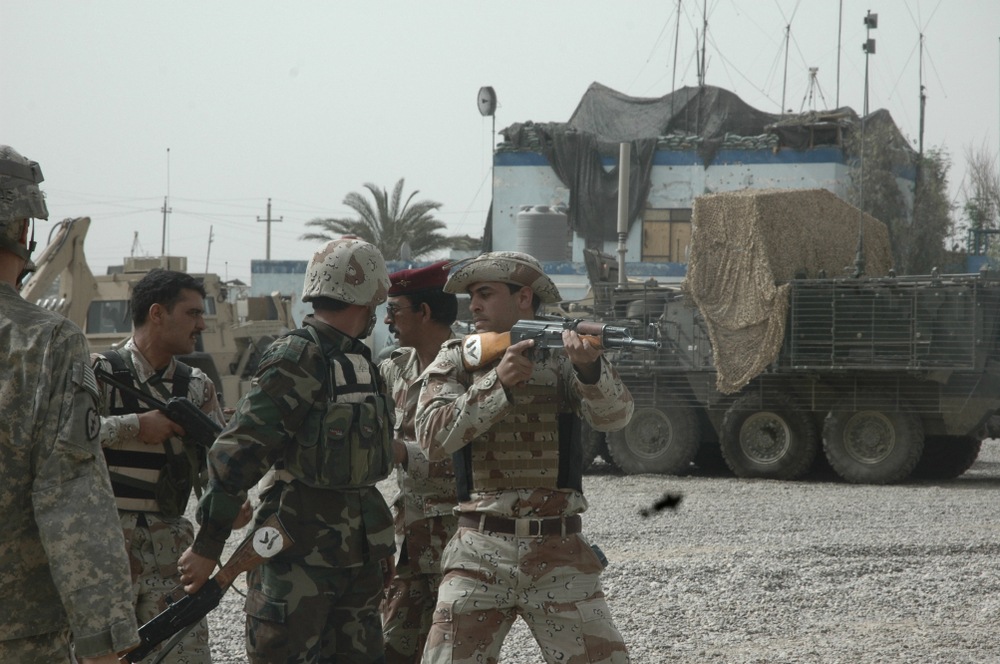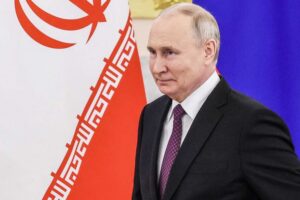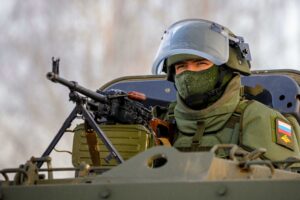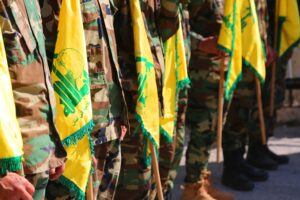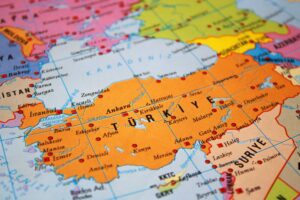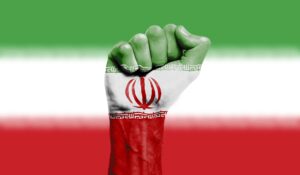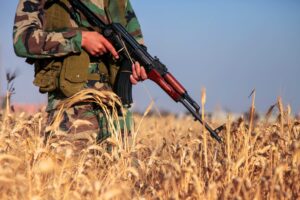By 2014, ISIS had taken a third of Iraq, and the Iraqi army had proved incapable of stopping the spread and recruitment of ISIS. With the help of the Global Coalition to Counter ISIS and the Iranian intervention in Iraq, ISIS slowly collapsed into insurgent cells in small desert pockets. Consequently, the fight against ISIS developed and solidified the Iranian-backed Popular Mobilization Forces (PMF), an Iraqi state-sponsored organisation of mostly Shia militia groups which helped win the war against ISIS. However, since the collapse of ISIS, the PMF has been accused of killing journalists, inflaming sectarian divides, and undermining the legitimacy of the Iraqi government. This has led to scrutiny from Iraqi civil society, government, and prominent leaders of the Shia community, such as Ayatollah Sistani. With the increased opprobrium that the PMF and Iran have generated, what does the future hold for the organisation?
Political Breakdown & Disintegration
The PMF has shown signs of political breakdown and infighting, as members question the leadership of the organisation. Since the assassination of IRGC Quds Force chief Qassem Soleimani and PMF commander Abu Mahdi al-Muhandis, there has been widespread disagreement within the PMF over the new leadership of Abdul Aziz al-Mohammedwi (nom de guerre Adu Fadak). Although Abu Fadak has close associations with the Iranians, there is widespread opposition to his leadership in his militia, Katiab Hezballah, which views him as the illegitimate chief of the PMF. Additionally, Ayatollah Sistani has called for his militia fighters to leave the PMF and join the Iraqi security forces, heightening tensions further as the organisation heavily relies on the Ayatollah’s edicts for legitimacy.
The recent attacks on US sites in Iraq are an attempt by militias to prove who is the mightiest.
Soleimani’s death has left a gaping hole in the authority of the PMF and has induced growing uncertainty within the organization itself on how to keep unity. A sign of disintegration within the PMF has been the recent attacks on US sites in Iraq. This is an attempt by militias to prove who is the mightiest, setting a precedent for violence to crescendo in the competition of the PMF hierarchy. Additionally, these divisions will lead to take military action being taken without consultation from Iran or the higher echelons of the PMF. Thus, the political breakdown and disintegration of the PMF will lead to further sporadic rocket attacks, militias continuing to detach themselves from the organisation, and the lack of consensus towards the leadership, which may well eventually lead to the organisation’s complete collapse.
Iran-Iraq Rift
Undoubtedly, since Soleimani’s death, Iran’s influence within Iraq has been greatly reduced. Soleimani built the network of Iran-backed militias in Iraq that fought ISIS. These all obeyed his patronage, and he attained a legendary status among the PMF. Additionally, Iran has also faced widespread condemnation within Iraq, accused of sewing sectarianism, killing innocent activists, and destabilising the Iraqi government. Following Soleimani’s assassination, Esmail Qaani became Commander of the Quds Force, and has faced adversity in exerting Iranian foreign policy in Iraq. For example, during Qaani’s visits to Iraq, the Iraqi government forced him to apply for visa entry, an act unheard of in Soleimani’s time. Additionally, militias have been paid with silver rings instead of usual direct cash payments, a gesture symbolic in Shiism but not of great financial value. Qaani has proven not to be the political strategist that Soleimani was, and due to the economic crisis in Iran, many militias are starting to seek financial support solely from the Iraqi state. Iran’s financial insecurity will lead militias to act more independently from Tehran’s commands and prerogatives.
The recent political distancing may not be intentional from Iran, as the country suffers from sanctions and the economic downturn of oil markets, but it is likely to have long-term effects on Iran's stronghold within Iraq.
Before the assassinations of Muhandis and Soleimani, there was an intention to unite the PMF branches into a more unified and professional organisation. Since then, Iran has shown little effort to rebalance the PMF political and military structure, and in fact, has let the organisation fall into disrepair. The recent political distancing may not be intentional from Iran, as the country suffers from sanctions and the economic downturn of oil markets, but this distancing is likely to have long-term effects on Iran’s stronghold within Iraq. Furthermore, Iran faces a political restructuring itself, as the death of Soleimani has forced the Quds Forces into a learning curve and unclear future of its own. All in all, the PMF is in financial trouble, placed low on Iran’s list of priorities, and struggling to find a leader like Soleimani who can hold the organisation together. This is a recipe for a PMF future which includes more sporadic actions, a foggy political alignment, and a diminishing cash flow.
Crackdown from the Iraqi State
The PMF once found that the state had been their greatest sponsor, with former prime ministers Nori al-Maliki and Hader al-Abadi using them to embolden Shia control of the country, and being as they were heavily influenced by Iran. However, since Prime Minister Mustafa Al-Kadhimi took office, three critical security concerns have defined his premiership: his distrust of and aggression towards the PMF; the frequency of assassinations of activists who oppose the PMF militias; and the precarious balance of power between those who want political reform and the PMF, which wish to continue the sectarianisation of the Iraqi state.
Although all of Iraq’s dominant parties agreed on Al-Kadhimi’s appointment, many of the leaders within the PMF rejected him as pro-American, including accusations that he gave the U.S. classified information that facilitated the killing of Soleimani and Muhandis. Also, Al-Kadhimi took office promising to reduce violence in the country, whereas the PMF has only increased violence, such as by shooting rockets in the International Zone, and aggression towards Iraqi security forces.
The ultimate goal for the Iraqi state is to integrate the militias into the Iraqi security forces. However, many militia groups within the PMF have no interest in doing so, and in fact, are distancing themselves from the Iraqi state. With these rising tensions between the Iraqi government and the PMF, direct clashes between the two fronts could escalate into a major civil conflict within the country. In this instance, the U.S. could well be provoked into protecting its alliance with Al-Khadimi’s government, and to push Iranian influence out of the region entirely.
Looking forward: The End of the PMF?
Three major concerns determine the future of the PMF:
- Political Unity: If the PMF does not find a new capable leader of the Soleimani and Muhandis mould, the group will exist in name only. The group needs to find a strategic alignment militarily, stronger political formation, and garner support from leading political figures within Iraq. Without this, the PMF would fall into incomplete disunity, and independent militias would continue their sporadic attacks on U.S. and Iraqi government targets.
- Alliance with Iran: Since the Iran-Iraq war, Iran has viewed border security and foreign influence in Iraq as integral. However, Soleimani and Muhandis’s untimely deaths, paired with Iran’s economic concerns, mean the PMF is currently being sidelined by Tehran. The PMF needs to find financial means outside of Iran, and an independent political brand distanced from affiliation with Iran. If they do not, further internal crumbling and external hostilities shall ensue.
- Baghdad’s Clampdown: In 2014, the global number one priority concerning Iraq was destroying ISIS, which entailed forcing the government to support the PMFs by any means. Now, the Iraqi government, civil society, and religious leaders are critical of the organisation’s actions and believe that the PMF is an assortment of unlawful militias that work at the behest of Iran. Baghdad’s patience is thin, and if the PMF does not make efforts to calm tensions, a war will likely occur between the government and militias. In this case, militias will defect to the government whilst stringent groups will fight resolutely for their survival. Nonetheless, without serious reconciliation attempts, the future does not look bright for the PMF or Iraqi internal stability.


